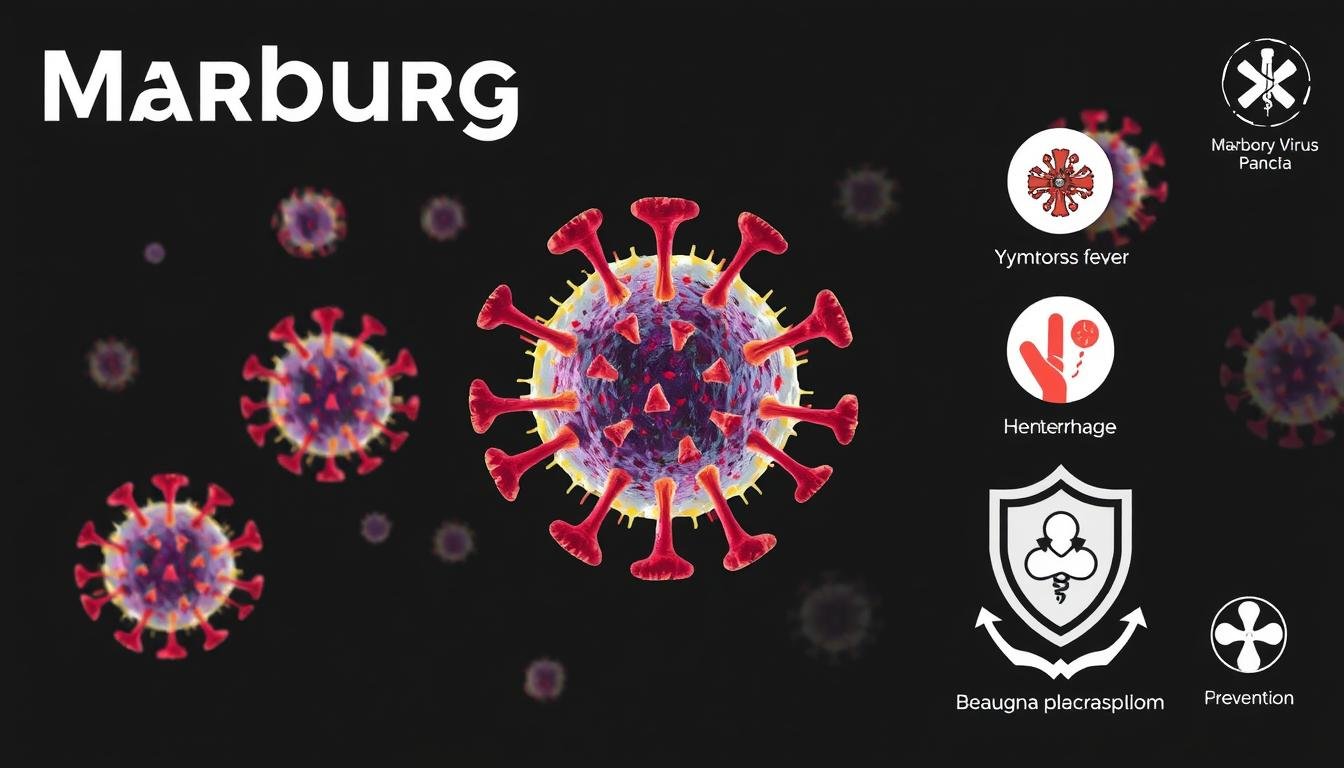Marburg virus disease is a rare but deadly illness. It spreads through contact with infected bats or people’s body fluids. Symptoms include fever, headache, rash, vomiting, bleeding, and confusion.
Knowing about marburg virus is key to stopping its spread. The disease has caused many deaths in Africa. It’s important to recognize its symptoms to prevent it.
The death rate for marburg virus disease is about 50%. Death usually happens 8 to 9 days after symptoms start. The time from getting infected to showing symptoms can be 2 to 21 days.
This disease can kill 20% to 90% of those who get it. It’s a big worry for public health.
Key Takeaways
- Marburg virus disease is a rare but often fatal illness caused by contact with the body fluids of infected bats or people.
- The symptoms of Marburg virus disease include fever, headache, rash, vomiting, bleeding, and confusion.
- Understanding the disease of the Marburg virus and its causes is crucial for preventing its spread.
- The Marburg virus outbreak has been reported in multiple African countries, resulting in high death rates.
- There are currently no licensed treatments for the Marburg virus disease, highlighting the need for supportive care.
- Infection prevention strategies emphasize avoiding contact with infected individuals’ body fluids, including their blood and semen.
Understanding Marburg Virus Disease
Marburg virus disease is a severe illness in humans, with a fatality rate of about 50%. It spreads from fruit bats to people and then among humans. Knowing how it spreads is key to stopping it.
Getting medical help quickly is vital for survival. But, many African countries lack the tools to diagnose this disease. This shows we need better ways to prevent it.
Some important facts about Marburg virus disease are:
* The first outbreak was in August 1967, with 31 cases.
* In Angola, the highest death rate was 88%.
* The biggest outbreak was in Angola, with 374 cases and 329 deaths.
* Survivors may face long-term effects like exhaustion and hair loss.
Things like deforestation and urbanization make it harder to understand the risks. The World Health Organization says we need better tests in Africa to fight this disease.
| Outbreak | Year | Cases | Deaths | Case Fatality Rate |
|---|---|---|---|---|
| Angola | 2004-2005 | 374 | 329 | 88% |
| Democratic Republic of the Congo | 1998-2000 | 154 | 128 | 83% |
| Uganda | 2012 | 26 | 15 | 58% |
Transmission and Spread
The marburg virus mainly spreads from infected Egyptian rousette bats to people. Once it jumps from animals to humans, sick people can pass it to others. Knowing how marburg virus spreads is key to stopping it.
Marburg virus can spread from person to person. This happens through direct contact like touching or shaking hands. It also spreads through indirect contact with things that have the virus. Most of this spread happens in homes or hospitals where safety rules are not followed.
Several things help marburg virus spread:
- There is no specific treatment or vaccine for the virus
- Poor safety practices in hospitals
- Being close to sick people or things they touched
Quickly finding and treating marburg virus is crucial to stop it. Marburg virus research is ongoing to find better treatments and vaccines. Spotting symptoms like fever and chills early can help stop more spread.
Early Warning Signs and Symptoms
It’s important to know the early signs of Marburg virus disease to get medical help fast. The marburg virus history shows symptoms can start 2 to 21 days after getting infected. On average, about 50% of people with the disease die.
The marburg hemorrhagic fever symptoms include severe fever, headache, and sudden malaise. Severe watery diarrhea starts by day three. Non-itchy rashes may show up 2 to 7 days after symptoms start in some.
Getting medical care right away is key if you’re exposed to Marburg and have symptoms. The virus spreads through direct contact with bodily fluids. Healthcare workers are at high risk if they don’t follow strict infection control.
The symptoms of Marburg virus disease go through several stages. These include:
- Initial symptoms: fever, headache, and malaise
- Advanced stage symptoms: severe watery diarrhoea, abdominal pain, and vomiting
- Emergency warning signs: bleeding, confusion, and severe respiratory distress
Knowing the early signs and symptoms of Marburg virus disease is crucial. It helps prevent the virus from spreading and lowers the risk of getting infected. By recognizing symptoms and acting fast, we can stop the virus from spreading and reduce severe illness and death.
High-Risk Groups and Vulnerability Factors
People working in local gold mines, mainly young men, face a higher risk of getting Marburg virus disease. This is because they often come into contact with infected bats and contaminated areas. Studies show that 87% of the 15 people who tested positive for Marburg antibodies were miners. The risk of getting infected was 13.9 times higher for miners compared to others.
Healthcare workers are also at risk, even if they didn’t test positive in the study. They might get marburg symptoms from contaminated needles or injuries. It’s crucial to focus on marburg treatment and prevention for these groups. This will help stop the disease from spreading and prevent a marburg outbreak.
The following table summarizes the key statistics related to Marburg virus disease:
| Category | Statistic |
|---|---|
| The case-fatality rate during the 1967 outbreak in Germany | 2% among 912 participants |
| Odds Ratio (OR) for working as a miner and testing positive for Marburg antibody | 13.9 (95% CI: 3.1 to 62.1) |
| was approximately 23% | approximately 23% |

Diagnosis and Detection Methods
Diagnosing Marburg virus disease is tough, but it’s key for treatment and marburg prevention. Doctors use tests like PCR, IgM-capture ELISA, and antigen-capture ELISA. They also isolate the virus in safe labs.
Knowing how marburg transmission works helps make better tests. The marburg virus in humans can be found through lab tests. These tests look for the virus’s genetic stuff or proteins.
- Testing should be done on a sample taken more than 72 hours after symptoms start for accurate results.
- Specimens must be shipped following Department of Transportation (DOT) rules.
- Shipping permits for Category A infectious substances need to be updated every two years.
Getting a diagnosis quickly and right is vital for treating and marburg prevention. By understanding marburg transmission and the marburg virus in humans, doctors can fight the disease better.
Treatment Approaches and Medical Care
Early intensive supportive care is key in treating Marburg virus disease. This includes rehydration and treating marburg virus symptoms like high fever and stomach issues. Recent marburg virus research shows that supportive care can help more people survive. But, there are no approved vaccines or antiviral treatments yet.
When there’s an outbreak of marburg virus, doctors focus on supportive therapy. This helps manage symptoms and prevent serious problems. The therapy might include:
- Rehydration and fluid management
- Pain management
- Respiratory support
- Infection control measures
Scientists are working hard to find treatments for Marburg virus disease. They’re looking at antiviral medications and vaccines. While some trials show promise, more research is needed to confirm their safety and effectiveness.

As we learn more about marburg virus research and marburg virus symptoms, we can develop better treatments and prevention methods. By keeping up with the latest research, we can reduce the impact of outbreaks of marburg virus and improve patient care.
| Treatment Approach | Description |
|---|---|
| Supportive Care | Rehydration, pain management, and respiratory support |
| Antiviral Medications | Under investigation, with promising results in clinical trials |
| Vaccines | Under development, with potential for future use in prevention and treatment |
Prevention Strategies and Safety Measures
To stop marburg virus disease from spreading, we need to protect ourselves and our communities. We must avoid touching infected people and things that might be contaminated. This helps lower the risk of getting the virus.
The CDC says the chance of getting marburg virus in the U.S. is still low. But, it’s important to know the signs and take steps to stay safe. People who have been to places with outbreaks are at higher risk, but most people don’t need to worry.
Personal Protection
Wearing protective gear like gloves, masks, and gowns is key when around possibly infected people. Also, washing your hands often with soap and water is crucial.
Community Prevention
Teaching people about marburg virus disease and how to prevent it is vital. This can be done through health campaigns, community programs, and education.
Here are some ways to stop marburg virus in our communities:
- Avoid close contact with sick people
- Don’t touch things that might be dirty
- Wash hands often with soap and water
- Stay away from places with outbreaks if you don’t have to
Healthcare Setting Protocols
In hospitals and clinics, it’s important to follow strict rules to prevent the virus. This includes isolating sick patients, wearing protective gear, and following infection control rules.
| Prevention Measure | Description |
|---|---|
| Isolation | Following proper infection control procedures, such as washing hands frequently |
| PPE | Wearing personal protective equipment such as gloves, masks, and gowns |
| Infection Control | Following proper infection control procedures such as washing hands frequently |
Global Impact and Recent Outbreaks
The marburg virus in humans has raised a lot of concern. It has a high death rate. Recent outbreaks show we need better ways to stop it.
As of 11 January 2025, Tanzania reported nine suspected cases of Marburg Virus Disease (MVD). Eight people died, making the death rate 89%.
Marburg virus outbreaks have happened all over the world. The Kagera region in Tanzania is a key area for disease spread. It’s because of the many people moving in and out.
Health experts are working hard to stop the virus. They want to reduce how it spreads from person to person. They also focus on quick care for anyone who might be sick.
Some important facts about recent outbreaks include:
- By October 15, Rwanda had 62 Marburg cases. 80% of these cases were among healthcare workers.
- There were 15 deaths from Marburg in Rwanda.
- The Sabin Vaccine Institute sent about 700 doses of an experimental vaccine to Rwanda for healthcare workers.
It’s crucial to raise awareness in the community. This helps in early reporting of symptoms and proper burial. Health facilities must follow WHO guidelines to reduce the risk of spreading the virus.
Testing for diseases like Marburg has gotten better. Now, we can use PCR testing and blood tests in many cities. The first time Marburg was found was in people who worked with monkeys from Uganda. This shows how animals can spread the disease.
| Country | Confirmed Cases | Deaths |
|---|---|---|
| Rwanda | 62 | 15 |
| Tanzania | 9 | 8 |
Research Developments and Future Outlook
Recent outbreaks of Marburg virus disease show we need more marburg virus research. This research aims to find effective treatments and ways to prevent the disease. There are promising candidate monoclonal antibodies, antivirals, and vaccines ready for clinical trials.
Knowing the Marburg virus symptoms early is key. The time from getting infected to showing symptoms can be 2 to 21 days. In severe cases, death often happens around 8 to 9 days after symptoms start. Researchers are working hard to understand the disease better and find ways to fight it.
Some important facts about the recent outbreak in Rwanda are:
- 58 confirmed cases of Marburg virus disease, including 13 deaths, as of October 8, 2024
- 70% of confirmed cases are among healthcare workers at two health facilities in Kigali
- Vaccination efforts began on October 6, 2024, with 700 doses of an experimental vaccine provided for clinical trials
These efforts show our dedication to fighting Marburg virus disease. They also stress the need for more Marburg virus research and better Marburg virus treatment options.
| Country | Confirmed Cases | Deaths |
|---|---|---|
| Rwanda | 58 | 13 |
Conclusion
The Marburg virus disease (MVD) outbreak in Tanzania is a harsh reminder of the danger it poses to global health. This virus can be deadly, with a fatality rate up to 90%. It’s important to stay alert, keep researching, and take steps to prevent its harm.
In Tanzania, over 100 cases of the virus have been reported, leading to 30 deaths. This shows how quickly the virus can spread and cause loss of life. It’s the first time the virus has been found in Tanzania, making it crucial to watch closely and prepare well.
To manage Marburg virus disease outbreaks, we need a few key steps. We must find cases early, isolate them, and use strong infection control. Healthcare workers need the right gear and tests to fight the Marburg virus outbreak well.
Even though there’s no vaccine yet for Marburg virus prevention, scientists are working hard to find one. We need to keep funding research and public health efforts. This is key to protecting our communities from this dangerous virus.


Leave a Reply